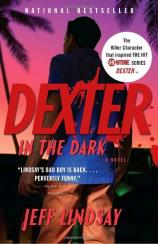Dexter In the Dark
Review
Dexter In the Dark
When
you think serial-killer mysteries, you probably imagine something
along the lines of SILENCE OF THE LAMBS or the new
novel HEARTSICK--- seriously grisly, psychologically twisted
stuff that’s best read by daylight. You don’t imagine
stories about a good-looking guy who lives in Miami, works for the
police department as a blood specialist, owns a boat and has both a
pretty divorced-mom girlfriend and an incredibly sardonic wit.
“So on a night like many others,” Dexter tells us,
“when the moon flung down chords of manic melody onto its
happily bloodthirsty children, I was humming along and preparing to
go out for a sharp frolic” (the author loves alliteration ---
perhaps a bit too much --- and puns; “pointed comments”
abound when discussing Dex’s passion for human
vivisection).
If you’ve read the first two Dexter books, or have seen the
Showtime drama (to which I am hopelessly addicted), you are already
familiar not only with the snappy narrative voice but also with the
fascinating premise of the series, which, for the benefit of
newcomers, I’ll restate here. Dex, after a traumatic
childhood, was taken in by a cop (the sainted Harry). When he
showed early homicidal tendencies, his remarkable foster father
taught him three crucial things: how to channel his psychopathic
energies into reprisals against murderers who have gone unpunished
by the official forces of order; how to pass for a normal person
with feelings; and, most important, how not to get caught.
So Dexter grows up to make a killing, so to speak (this pun thing
must be catching), and again Lindsay surprises us by supplying a
bright, buzzy setting that plays against the horrific nature of his
hero’s secret inclinations. Instead of bleak, creepy urban
streets, we have Miami, getaway capital of the USA: the heat, the
beat, the frantic traffic (“You just have to relax and enjoy
the violence”), the soul-stirring food (Cuban steak
sandwiches, fried plantains, mango milkshakes). This is local color
with a vengeance.
Equally ironic is Dexter’s personal situation, which feels a
little like a ghoulish sitcom. Somehow he has become engaged to his
girlfriend Rita, she of the abusive ex-husband and two small kids,
and he is suffering all the pre-wedding slapstick that men in a TV
comedy series typically endure --- picking the music, meeting the
minister, hiring the caterer. The funny thing is that when
Dexter’s lack of real emotion leaves him stumped about what
to do next, he often thinks of movies or television shows, and the
scripts show him how to act properly (“I quickly changed
course, diving straight into tactics learned from pretending to be
human for so many years. ‘Rita,’ I said, ‘the
important part of the wedding is when I slip the ring on your
finger. I don’t care what we eat
afterward.’”).
With the kids, though, faking is useless, because they ---
especially the little boy --- appear to have dark inner selves of
their own and have outed Dexter almost immediately (it takes one to
know one). He soon realizes that his stepfather role will be more
“The Addams Family”than “Father Knows
Best”; Harry, not Rita, will be his best guide for how to
bring these children up --- not by denying that they have murderous
inclinations but by displacing these impulses from the neighborhood
cat or bully to somebody who really deserves to die. And during all
this, poor Rita --- prattling away about the wedding ---
doesn’t have a clue. (Lindsay, I think, makes her a bit too
credulous.)
That’s because Dexter’s real soul mate isn’t his
fiancée but his Dark Passenger --- his name for the creepy
inner self, the “id monster” who inhabits him, drives
him, empowers him, makes him who he is. (Lindsay likes to play
satirically with the clichés of self-acceptance and
self-knowledge.) The signal event of DEXTER IN THE DARKis the
sudden disappearance of this private voice, leaving Dexter
unknowable even to himself. He feels lobotomized rather than
liberated. And now the bad guys are pursuing him, not the other way
around: “Is this what it was like to be human?” he asks
himself. “To walk through life with the perpetual feeling
that you were meat on the hoof, stumbling down the game trail with
tigers sniffing at your heels?” There is a great chase
sequence in which Dexter turns the table on a car that has been
shadowing him and does battle with the forces of evil.
Which are…? Oh, sorry, I forgot to mention that this
is a mystery, not a black comedy or French
existentialist novel. There is a typically bizarre unsolved case:
headless corpses that have been somehow…baked. Dexter’s
foster sister, Deborah, a homicide detective with the Miami police,
is in charge, and when it comes to ritualistic serial killings she
is accustomed to relying on her foster brother’s peculiarly
accurate instincts. Dexter, however, is coming up empty because,
natch, it’s the Dark Passenger who always had these insights,
and the DP’s desertion happened right around the time the
first victims were discovered. And the same…force, for
want of a better word (here we get a touch of the sort of Ancient
Evil stuff made popular by THE DA VINCI CODE and THE
HISTORIAN), that scared away the DP and is responsible for the
weird murders is also stalking Dexter and his soon-to-be new
family.
The only problem with the series is that I’m substantially
more engaged by Dexter himself, his warped and ever-evolving
psyche, than by the whodunit aspect per se. The real tension is how
long our gay blade can go on masquerading as an ordinary dullard.
Will he actually get married (“a quantum leap forward, onto a
new level of human camouflage”)? Will his stepchildren follow
in his (bloody) footsteps? Will Rita ever get wise? Stay
tuned.
Reviewed by Kathy Weissman on December 29, 2010





